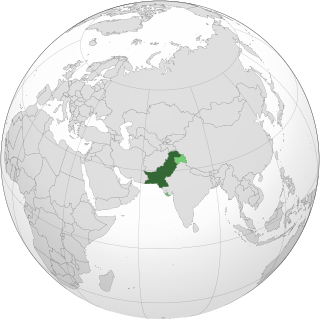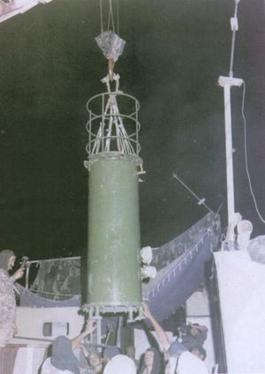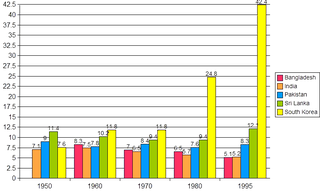Related Research Articles
In nuclear strategy, minimal deterrence, also known as minimum deterrence and finite deterrence, is an application of deterrence theory in which a state possesses no more nuclear weapons than is necessary to deter an adversary from attacking. Pure minimal deterrence is a doctrine of no first use, holding that the only mission of nuclear weapons is to deter a nuclear adversary by making the cost of a first strike unacceptably high. To present a credible deterrent, there must be the assurance that any attack would trigger a retaliatory strike. In other words, minimal deterrence requires rejecting a counterforce strategy in favor of pursuing survivable force that can be used in a countervalue second strike.

Muhammad Zia-ul-Haq was a Pakistani military officer who served as the sixth president of Pakistan from 1978 until his death. He also served as the second chief of the army staff of the Pakistan Army from 1 March 1976 until his death.

Mian Muhammad Nawaz Sharif is a Pakistani businessman and politician who served as the Prime Minister of Pakistan for three non-consecutive terms. He is the longest-serving prime minister of Pakistan, having served a total of more than 9 years across three tenures. Each term has ended in his ousting.

Zulfikar Ali Bhutto was a Pakistani barrister, politician, and statesman. He served as the fourth president of Pakistan from 1971 to 1973 and later as the ninth prime minister of Pakistan from 1973 to 1977. Bhutto founded the Pakistan People's Party (PPP) and served as its chairman until his execution.

The Pakistan People's Party is a centre-left political party in Pakistan. It is currently the first-largest party in the Senate and third-largest party in the National Assembly. The party was founded in 1967 in Lahore, when a number of prominent left-wing politicians in the country joined hands against the military rule of president Muhammad Ayub Khan, under the leadership of Zulfikar Ali Bhutto. It is affiliated with the Socialist International. The PPP's platform was formerly socialist, and its stated priorities continue to include transforming Pakistan into a social-democratic state, promoting egalitarian values, establishing social justice, and maintaining a strong military. The party, alongside the Pakistan Muslim League-Nawaz and the Pakistan Tehreek-e-Insaf, is one of the three largest political parties of Pakistan.
Ghulam Ishaq Khan, commonly known by his initials GIK, was a Pakistani bureaucrat, politician and statesman who served as the seventh president of Pakistan from 1988 to 1993. He previously served as Chairman of the Senate from 1985 to 1988 under president Muhammad Zia-ul-Haq, and was sworn in shortly after Zia's death.

India possesses nuclear weapons and previously developed chemical weapons. Although India has not released any official statements about the size of its nuclear arsenal, recent estimates suggest that India has 170 nuclear weapons and has produced enough weapons-grade plutonium for up to 200 nuclear weapons. In 1999, India was estimated to have 800 kilograms (1,800 lb) of separated reactor-grade plutonium, with a total amount of 8,300 kilograms (18,300 lb) of civilian plutonium, enough for approximately 1,000 nuclear weapons. India has conducted nuclear weapons tests in a pair of series namely Pokhran I and Pokhran II.

Pakistan is one of nine states that possess nuclear weapons. Pakistan began developing nuclear weapons in January 1972 under Prime Minister Zulfikar Ali Bhutto, who delegated the program to the Chairman of the Pakistan Atomic Energy Commission (PAEC) Munir Ahmad Khan with a commitment to having the device ready by the end of 1976. Since PAEC, which consisted of over twenty laboratories and projects under reactor physicist Munir Ahmad Khan, was falling behind schedule and having considerable difficulty producing fissile material, Abdul Qadeer Khan, a metallurgist working on centrifuge enrichment for Urenco, joined the program at the behest of the Bhutto administration by the end of 1974. Producing fissile material was pivotal to the Kahuta Project's success and thus to Pakistan obtaining the capability to detonate a nuclear weapon by the end of 1984.

The Pokhran-II tests were a series of five nuclear bomb test explosions conducted by India at the Indian Army's Pokhran Test Range in May 1998. It was the second instance of nuclear testing conducted by India; the first test, code-named Smiling Buddha, was conducted in May 1974.

The National Command Authority (NCA) is an independent federal agency of the Government of Pakistan that is responsible for safeguarding of the national security through the military applications of the nuclear science.

Chagai-I is the code name of five simultaneous underground nuclear tests conducted by Pakistan at 15:15 hrs PKT on 28 May 1998. The tests were performed at Ras Koh Hills in the Chagai District of Balochistan Province.
The Nuclear doctrine of Pakistan is a theoretical concept of military strategy that promotes deterrence by guaranteeing an immediate "massive retaliation" to an aggressive attack against the state.
The political history of Pakistan is the narrative and analysis of political events, ideas, movements, and leaders of Pakistan. Pakistan gained independence from the United Kingdom on 14 August 1947, when the Presidencies and provinces of British India were divided by the United Kingdom, in a region which is commonly referred to as the Indian subcontinent. Since its independence, Pakistan has had a colorful yet turbulent political history at times, often characterized by martial law and inefficient leadership.

The Libya–Pakistan relations are the international and bilateral relations between Libya and Pakistan. The relations remains friendly and bonded throughout its history as both countries shares similar religious identities, cultural links, particularly their Islamic heritage. The bilateral relations were established in the 1950s when King Idris agreed to provide financial aid to the then impoverished Pakistan.

The Hatf Program was the classified program by the Ministry of Defence (MoD) of Pakistan for the comprehensive research and the development of guided missiles. Initiatives began in 1986–87 that also received support from Prime Minister Benazir Bhutto in a direct response to India's equivalent program in 1989.

Sartaj Aziz was a Pakistani economist and strategist, who had previously served as the deputy chairman of the Planning Commission of Pakistan, member of the federal cabinet as the de facto Minister for Foreign Affairs, a Federal Senator as well as the National Security Advisor.

The Nationalisation process in Pakistan was a policy measure programme in the economic history of Pakistan that negatively impacted the country's industrialization and undermined the trust of businessmen and investors. The process was first introduced, promulgated and implemented by Zulfikar Ali Bhutto and Pakistan Peoples Party to lay the foundation of socialist economics reforms to improve the growth of the national economy. Since the 1950s, the country had undergone a speedy industrialisation. But, as time progressed, the labour trade unions and labour-working class had increasingly strained relations with the industrial business oligarch class, having neglected to improve working conditions and failing to provide a healthy and safe environment for the workers in these industrial industries.

The Privatisation process in Pakistan is a continuous policy measure program in the economic period of Pakistan. It was first conceived and implemented by the then-people-elected Prime Minister Nawaz Sharif and the Pakistan Muslim League, in an attempt to enable the nationalised industries towards market economy, immediately after the economic collapse of the Soviet Union in 1989–90. The programme was envisaged and visioned to improve the GDP growth of the national economy of Pakistan, and reversal of the nationalisation programme in 1970s— an inverse of the privatisation programme.

Pakistan and the Soviet Union had complex and tense relations. During the Cold War (1947–1991), Pakistan was a part of Western Bloc of the First World and a close ally of the United States.

The Cabinet Committee on National Security (CCNS or C2NS), (Urdu: کابینہ کمیٹی قومی سلامتی) previously known as the Defence Committee of Cabinet, is the principal federal institution and consultative forum used by the people-elected Prime Minister of Pakistan for concerning matters of state's national security, geopolitical, geostrategic, and foreign policy matters with the Prime minister's chief military advisers, senior government advisers and senior Cabinet ministers.
References
- ↑ "Pakistan's latest nuclear antics in the form of Full Spectrum Deterrence". orfonline.org. Retrieved 23 January 2024.
- ↑ Ghumman, Khawar (15 July 2011). "N-deterrence to be pursued". Dawn Newspapers, 2011. Dawn Newspapers Group. Retrieved 23 November 2012.
- 1 2 Siddiqi, Muhammad Ali (20 April 1995). "N-deterrent vital to security, says PM Bhutto". Los Angeles Times. Archived from the original on 9 June 2012. Retrieved 18 November 2011.
- ↑ Farah Zahra, PhD (Political Science) (12 August 2011). "Credible minimum nuclear deterrence". Daily Times. Retrieved 19 July 2012.
The nuclear arms race in South Asia is not purely a quantitative matter; it encompasses a qualitative dimension where the nuclear weapons and delivery systems on both sides are improving in quality as well ... dr. Farah Zahra
- 1 2 3 4 5 6 7 8 9 10 11 IISS. "Nuclear policy, doctrine and planning Rationales for nuclear weapons". International Institute for Strategic Studies. Archived from the original on 28 June 2012. Retrieved 19 July 2012.
- ↑ Kerr, Paul K.; Mary Beth Nikitin (10 May 2012). "Pakistan and Nuclear weapons". United States Government. United States Congress: Congressional Research Services. p. 1. Retrieved 19 July 2012.
- ↑ Tertrais, Bruno. "No First Use, No Deterrence". Strafasia | Strategy, analysis, News and insight of Emerging Asia. Retrieved 25 June 2020.
- ↑ Dixit, J. N. (2 September 2003). India-Pakistan in War and Peace. ISBN 9781134407583.
- ↑ See: Nuclear policy, doctrine and planning, Rationales for nuclear weapons at the International Institute for Strategic Studies published page.
- 1 2 3 Abidi, Zawar Haider. "Threat Reduction in South Asia". Zawar Haider Abidi. p. 6/15. Retrieved 21 July 2012.
- ↑ ANI, ANI (22 March 2011). "Peace-loving' Pakistan to continue credible minimum nuke deterrence policy". The Yahoo! News. Retrieved 21 July 2012.
Pakistan does not wish to enter into a nuclear arms race, but will continue to maintain the policy of credible minimum deterrence, Pakistan's Air Force chief Marshal Rao Qamar Suleman has said
- ↑ "Pakistan will maintain minimum credible deterrence". Daily Times. 28 February 2006. Archived from the original on 25 April 2006. Retrieved 21 July 2012.
- ↑ Khan, Feroz Hassan (22 November 2012). "The Route to Nuclear Ambition" (google book). Eating grass: The making of the Pakistani bomb. Stanford, California: Stanford University Press. pp. 119–120. ISBN 978-0804776011 . Retrieved 9 January 2013.
- ↑ Babar (MSc in Civil Engineering), Farhatullah. "Bhutto's Footprints on Nuclear Pakistan". Zulfikar Ali Bhutto "The Myth of Independence". Farhatullah Babar and Courtesy The News International. Archived from the original on 25 November 2010. Retrieved 26 January 2012.
- ↑ Anjali, Ghosh (2009). India's Foreign Policy Pakistan Factor. New Delhi: Repro India Ltd. p. 92. ISBN 978-8131710258.
- ↑ Khan, Zafar. "Pakistan's authorization of the nuclear testing programme: External and Internal Pressures". Zafar Khan, game theorist and nuclear strategist at the Islamabad Policy Research Institute (IPRI). Islamabad Policy Research Institute (1998). Retrieved 21 July 2012.
- 1 2 Staff reports (31 March 2012). "Pakistan to maintain conventional balance: PM". The Nation. Archived from the original on 2 April 2012. Retrieved 19 July 2012.
Our military capability is basically for deterrence purpose while peace remains the ultimate cherished goal for us. We believe that military weakness invites aggression from stronger nations
- 1 2 3 4 Rasheed Khalid (2 February 2011). "Pakistan has to maintain minimum credible nuclear deterrence: expert". The News International. Retrieved 19 July 2012.
- ↑ Saman Zulfiqar. "Pak minimum deterrence posture". Pakistan Observer . Retrieved 19 July 2012.
- ↑ "Pakistan's nuclear capability is purely for defensive purposes". Pakistan Atom Publishers. Retrieved 19 July 2012.
Our nuclear capability is purely for defensive purposes. We believe in peaceful co-existence and reconciliation and will always strive for peace and prosperity in our region.
